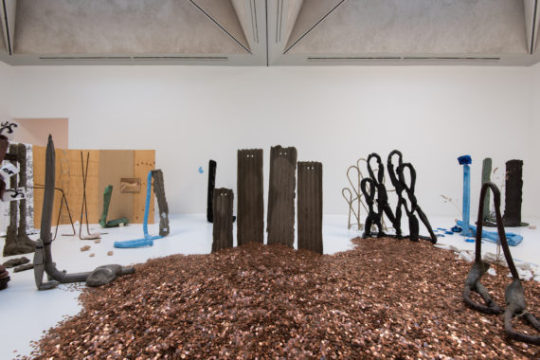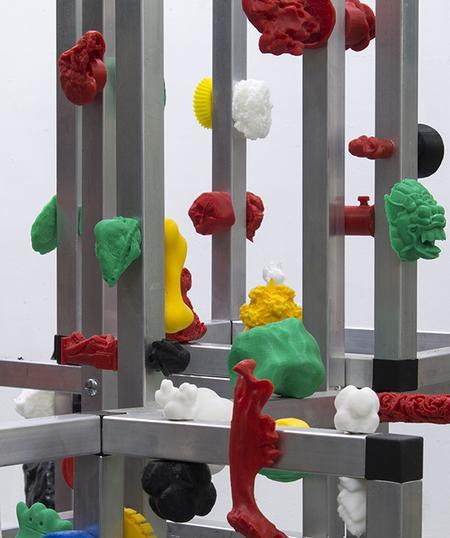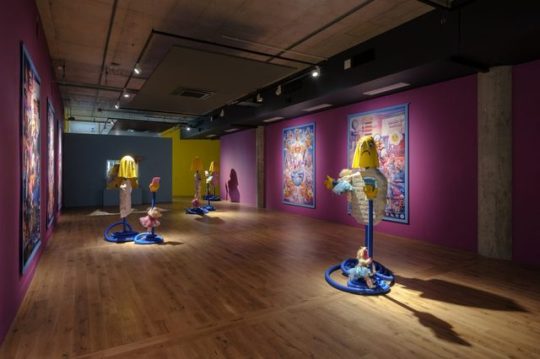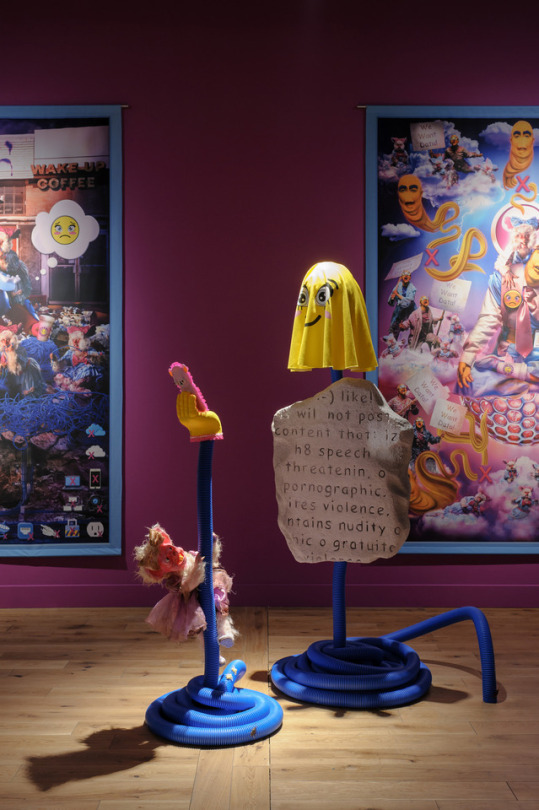Photo




Turner Prize 2016 - Michael Dean
Visiting the 2016 Turner Prize turned out to be one of the most important parts of this year in terms of study visits as it allowed me to think outside the box in relation to what I was making in the studio. I felt very stuck in constantly long processes or making moulds, filling and waiting to take them out, and it was becoming boring as it stopped me from being as creative in the studio and I felt confined to the sculpture workshop. Seeing Dean’s work really hit home for me as it showed that sculpture can be made intensely fast with not many materials, whilst still conveying a message and looking visually effective.
I fell in love with his work, and this gave me the urge to balance out my practice with faster ways of working such as casting forms in plastic bags, drawing, not feeling too personal with all my pieces which allowed me to quickly deinstall and rearrange layouts, as well as working more with substances such as playdoh and found objects.
I bought his book ‘Now Leaves’ from the exhibition, and instantly was possessed by it. The text explores a particular ‘tongue’ form and is almost unreadable, disguised by disfigured letters and scrolling text. I felt compelled to read even though I couldn’t figure out a lot of the words. I am not sure if this informs my studio practice, but it is incredibly interesting how something so simple could consume me so much, along with seeing the language next to his work was an engaging experience and you could really see and understand both pieces.
"NOW LEAVES describes leaving and having left. Glossolalia like, against noise, about the bones of a writing, written in tongue graphics legible by reason of the trees with as many words as there are leaves. The percussion of these leaves is f***ing news. The percussion of these leaves is not his news. The percussion of these leaves is not her news. The percussion of these leaves is definitely not their news. NOW LEAVES presents itself as a block. Physically it adopts the scale of a human hand, its weight present, its structure flexible, almost human. The pages fall loosely apart to reveal dense black graphics letters shaped as tongues, twisted to form barely legible words. Each page inscribed, playing on repetition, the word 'leaves' repeatedly tongued. The successive pages form statements, occasionally benign it starts LEAVES FOR LEAVES but as the pages turn a more visceral violence exudes from the pages SLAVE LEAVES HAPPY LEAVES, FUCKING LEAVES LOST LEAVES KILL LEAVES, BLOODY LEAVES POSITION LEAVES. Whilst visually arresting, the experience of reading Dean's book reduces reading to the physical intimacy of your own mouth; as you to attempt to read the barely decipherable words to take pleasure in the babble, you feel your eyes contort as your own tongue does trying to shape the words, tempted to twist, stretch or replicate the graphic tonguing on the page." --Michael Dean
0 notes
Text
Wot u :-) about?
‘it is much harder to point a perfectly polished gel nail at the grotesque reality of contemporary exploitation than it is to tap your choice of smiley emoji buttons.’ p5
‘Maclean’s films show the way that industries and their advertising tools create and form the subjectivity of the people they target as their consumers’ p10
‘Maclean’s films repeatedly slip away from being stories and enter the world of advertising and product placement’ p10
‘Elsewhere in Over the Rainbow, naff little rocks with ‘faith’, ‘love’, ‘hope’ etched into them travel down a conveyor belt: human emotions reduced to commodities, you might think. But even these break apart as cutesy, glowing, bear-like little figures step out of them, to be placed as toys in Happy Meals.’ p10
‘fairy-tale stories: that of giving children a moral and ethical framework in which to teach them how to make decisions in the future’ p11
‘all art is subject to commodification, and this commodification has no other purpose than to capture and play upon - in order to profit from - our desire for pleasure and happiness.’ p11
‘post-internet are contains a vexed relationship to commodity critique; in fact, rather than opposing commodity capitalism, it often welcomes it.’ p12
‘in showing a world constituted by consumer objects, one can’t escape the reminder that Maclean’s work, often sharing an aesthetic with these products, is also itself a commodity sold to us.’ p12
‘in the last decade, touchscreen interfaces have become ordinary features of everyday life, in the form of smartphones and tablets. on the the curious cultural effects of this is a complete levelling of critical insight and skilled dexterity: anyone can swipe or touch. anyone can choose between ‘like’ and ‘don’t like’ no lessons are needed, as they are for use of numbers or words. in fact, a small child can do it just as well as an adult.’ p45
‘the consumer is locked into the experience of now, followed immediately by another now.’ p47
‘without chronological coherence, adults and children become united in an instinctive desire to be fed more now, from which some get rich and others get off’ p48
0 notes
Text
Preliminary Materials For a Theory of the Young-Girl
“The intimacy of the Young-Girl, now equivalent to all intimacy, has become something anonymous and exterior, an object.” p24
“Adolescence is a recent category created according to the demands of mass consumption.” p26
“supported by the economy through the arousal of corresponding consumer needs.” p32
“’How can I become beautiful? ...’to look young and beautiful both now and forever’” p32
“The Young-Girl occupies the central node of the present system of desire.” p42
“The ‘tyranny of pleasure’ does not incriminate pleasure, but tyranny.” p44
“The Young-Girl doesn’t age. She decomposes.” p45
“a refrigerated consciousness living in exile in a plasticised body.” p47
“The Young-Girl has sexuality in the exact proportion to which all sensuality is foreign to her.” p51
“The depth of penetration of this consumer junk can be read in the intensity of the feeling of the self as meat.” p54
“The Young-Girl is like capitalism, domestic servants, and protozoa: She knows how to adapt and what’s more, she’s proud of it.” p56
“The Young-Girl is both production and a factor of production, that is, she is the consumer, the producer, the consumer of producers, and the producer of consumers.” p65
“’Seduction: learn love marketing! You dream about him, he doesn’t notice. Snag him with the laws of marketing. No man can resist a well-conceived marketing campaign. Especially if the product is you.’” p84
“The Young-Girl never allows herself to be possessed as a Young-Girl in the same way that a commodity never allows itself to be possessed as a commodity, but only as a thing.” p85
“’No, my body is not a piece of merchandise. It’s a tool for work.’” p86
I found this book incredibly difficult to read due to the lengthy and over-intelligent way of wording. Whilst I was reading it, I understood it but looking at my notes I realise I could not understand unless I was completely in the moment whilst reading. One thing to note is that the Young-Girl is a the complete product and model citizen of consumer culture. The way the book is written, in multiple different size and font text alludes to advertising and the way the we absorb certain information from the media.
1 note
·
View note
Text
Ads, Fads and Consumer Culture
“Advertising tries to attract the attention, create the desire for, and stimulate action that leads to the purchase of products and services....advertisers hope to convince, to persuade, to motivate, and most importantly, to get people to act, to do something.” p4
“all they know is what they can buy” p14
“consumer cultures are those in which has been a great expansion of commodity production, leading to societies full of consumer goods and services and places where these can be purchased.” p23
“the very act of consumption has now also become aestheticised and sexualised and is itself the source of a great deal of pleasure.” p23
“One problem with consumer cultures is that people become too caught up in consuming things as a means of validating themselves and proving their worth.” p28
“Needs are finite but desires are infinite, and thus, as soon as our needs have been taken care of, we become obsessed with what we don’t have but want.” p29
“what advertising does is manufacture desire and shape it, and thus create people who are insatiable and who have been conditioned to continually lust for more things.” p29
“Advertising, in its entirety constitutes a useless and unnecessary universe. It is pure connotation. It contributes nothing to production of to the direct practical application of things, yet it plays and integral part in the system of objects not merely because it relates to consumption but also because it itself becomes an object to be consumed.” Baudrillard The System of Objects p32
This book was incredibly useful for me to understand the way consumer cultures work, and how reliant on consumption we really are. We are a piece of clay underneath their fingers, molded into whatever they want from us.
0 notes
Text
Culture Jam: How to reverse America’s suicidal consumer binge and why we must
‘change the way we interact with the mass media and the way in which meaning is produced in our society’ pxi
‘our role is mostly to listen and to watch - and then, based on what we have heard and seen, to buy’ pxiii
‘a free authentic life is no longer possible’ pxiii
‘we ourselves have been branded’ pxiii
‘the most powerful narcotic in the world is the promise of belonging’ pxiii
‘honour your instincts’ pxv
‘society of spectacle’ pxvi
‘loss of their selves’ p4
‘the generations alive today are the first to have had their lives shaped almost entirely by the electronic mass media environment’ p4
‘someone has gotten inside your brain and really fucked you up’ p6
‘rampant, oblivious consumption’ p6
‘real life has become an alien landscape’ p7
‘alive when she’s in front of the tv’ p7
‘alive when he’s surfing the net’ p7
‘media trance’ p7
‘most of us spend the majority of our time in some ethereal place created from fantasy & want’ p7
‘the hyperreality of this place comes to seem normal’ p7
‘curse of plentitude, the image explosion, the data overload, the hum of the media’ p11
‘we receive but we do not transmit’ p11
‘identical images flow into our brains, homogenising our perspective, knowledge, taste and desires’ p11
clockwork orange: ‘the colours of the real world only become real when you viddy them in a film’ p12
‘absorbing massive daily doses without a second thought’ p13
‘need to be equally careful about what we take into our minds’ p13
‘stimulation’ p14
‘we face more and more opportunities and incentives to spend time in cyberspace or to let the tv do the thinking. this is ‘unreality’: a medicated world so womblike and seductive, its hard not to conclude its a pretty nice place to be’ p22
‘important advertisers are stroked with ‘soft’ pieces designed to move product while important stories are buried’ p34
‘because theyre everywhere, theyre nowhere. you dont really notice them. just as you probably dont notice brand names in novels or songs.’ p38
on about how when tourists see something beautiful they ‘reflexively put their cameras to their eyes. only when these things were thus ‘framed’ did they become valid. only when they were memorialised on film did they live. this, i think, is the hazardous fall out from an overmediated world, where nothing that happens becomes real until you can make it fit into the spectacle, or make the spectacle into it.’ p45
‘MUD addicts end up inhabiting a world somewhere between real life and virtual life. its too real to be a game, yet too artificial to be real. they hover in “the gap”’ p45
‘if you spend enough time in cyberspace, emote commands start taking the place of emotions. “emoticons”” p46
‘”connect, disconnect” may be our generation’s answer to “tune in, turn on, drop out.”’ p46
‘The citizens of this new world order are trapped inside their living rooms, roaming the thousand-channel universe and exercising the one freedom they still have left: to be the voyeurs of their own demise’ p47
‘We’re free to roam and recreate. no one seems to be forcing us to do anything we dont want to do. in fact. we feel privileged to be here. the rules dont seem oppressive. but make no mistake; there are rules.’ p53
‘you watch tv. its your sanctuary. you feel neither loneliness nor solitude here.’ p55
‘you have moved so far into the consumer maze that you can smell the cheese’ p55
‘You buy a house with three bathrooms. you park your BMW outside the double garage. when you grow depressed you go shopping.’ p55
‘when “consumer confidence is down”, spending is “stagnant”, the “retail sector” is “hurting” and “stingy consumers are giving stores the blues”, you do your bit for the economy. you are a star.’ p57
‘dreams, by definition, are supposed to be unique and imaginative. yet the bulk of the population is dreaming the same dream. its a dream of wealth, power, fame, plenty of sex and exciting recreational opportunities.
what does it mean when a whole culture dreams the same dream?’ p57
This book was extremely influential and informative. It helped me learn how excessively and easily we absorb information from the media and advertising, using technology as a way to escape our banal lives. This relates to my practice as I try to make work that reflects our consumer culture and opens truths about the world we are living in.
0 notes
Text
Anti-Oedipus: Capitalism and Schizophrenia
‘pleasure of violating a taboo’ p7
‘the rule of continually producing production, of grafting producing onto the product, is a characteristic of desiring-machines or of primary production: the production of production.’ p7
‘producing, a product: a producing/product identity.’ p7
‘believing in the intrinsic power of desire to create its own object - if only in an unreal, hallucinatory, or delirious form - or from representing this causality as stemming from within desire itself. The reality of the object, insofar as it is produced by desire, thus a psychic reality.’ p25
‘if desire is the lack of the real object, its very nature as a real entity depends on an “essence of lack” that produces the fantasized object. Desire thus conceived of as production, though merely the production of fantasies...the real object that desire lacks is related to an extrinsic natural or social production, whereas desire intrinsically produces an imaginary object that functions as a double of reality, as though we were a “dreamed-of object behind every real object”, or a mental production behind all real productions’ p25-6
‘if desire produces, its product is real. If desire is productive, its can be productive only in the real world and can produce only reality.’ p26
‘Desire and its object are one and the same thing: the machine, as a machine of a machine. Desire is a machine, and the object of desire is another machine connected to it.’ p26
‘Desire does not “want” revolution, it is revolutionary in its own right, as though involuntary, by wanting what it wants’ p116
This was an interesting read in comparison to Freud’s work. Through ideas around sexuality, fetishism and pleasure we start to understand how it could be possible to desire an object, and how a desire comes into play.
0 notes
Text
A Philosophy of Computer Art
‘digital images are transmissible. since the display you see on Flickr is generated from a digital file, the very same image can be displayed on countless different computers, and each one of these screen images is an authentic display of the work - not a reproduction.’ p5
‘by encoding text, sound, and still and moving images, digital displays offer one-stop multimedia’ p8
‘when images, text, sound, and traditional art media appear in computer art, they’re harnessed to achieve something not found in other art: interactivity.’ p27
‘The value of an art work is measured by its power to provoke and sustain hard thinking, and works that fail this test of profundity fail as art. Such is the destiny of computer-based art, which gives us techno-dazzle in place of content, blocks serious reflection, and corrodes the imagination, all the while blinding us to its mind-numbing effects.’ p30
mass art as mind numbing (movies, TV and popular music) - Greenberg, Horkheimer, Adorno p31
‘Virtual reality art and interactive art impede active thought because they’re immersive, but active thought requires distance, which is incompatible with immersion.’ p31
‘Adorno writes that high tech art media are designed to “enhance the power of the powerful” by blocking the “development of autonomous, independent individuals who judge and decided consciously for themselves”’ p33
‘New media art works don’t challenge the mind the way traditional works do. Given their seductive slickness and commercial ties, they manipulate us as consumers.” p33-4
By creating digital art, I think this has negative connotations in the art world as it is not classed as ‘art’ but more graphics or design. Recently there has been a surge in internet and computer based artwork, and I really wanted to harness this ‘trend’ as I felt it was an appropriate way to explore mass consumption of data, virtual realities, online personas. I am interested in this idea of computer art not being immersive as I think this is completely untrue, think about video games and how players can obsessively play for days at a time. VR has become a new, upcoming form of art and I would love to experiment with this. Our addiction to computers, the online and the internet just shows how immersive it can be - we have everything in the world at our fingertips.
I find the correlation between commercial advertisements and computer based art a fascinating one, because this is exactly what I want to harness within my work.
0 notes
Text
Art After Social Media
‘the majority of views an artists work gets online is often not through her own website, but through the accumulated network of re-blogs, links, and digital reproductions that follow it through social media’ p39
‘when users of social media are able to move powerfully define the context (and thus the meaning) of an artwork’ pg 39
‘images of art work can travel as fast as an audience commands’ pg 39
‘the image is being used for a purpose entirely unrelated to the artists intentions. In case, the non-artists appropriate art as entertainment, office humour, a visual backdrop, or pornography’. pg 40
‘swap the external commodity for the commodification of themselves through online social networks.’ pg 40
‘Content always floats away, but if the source of that content is unique, people will continue to come back.’ pg 40
‘follow me’, ‘friend me’, ‘subscribe and comment’, are the endless pleas made by a generation of artists struggling to gain the greatest amount of attention.’ pg 41
‘the long- describes notion of the masterpiece has reached its logical antithesis, as immediacy and sped have come to trump craft and long-term contemplation of these creators’ pg 42
‘the larger cultural zeitgeist- for example, Duchamp’s readymade came at a time of transition when consumers were first buying mass-produced goods’ pg 42
‘the digital economy that mimics the digital economy of stock trading, a market increasingly dominated by computer- auto-generated algorithmic trades. For these artists, art is no longer merely traded like a stock- its created like one, too.’ pg 42
‘Time spent on anything is time time worth being redeemed in attention. For the audience, what is lost in production value is gained in openness and personal connections with the creator’ pg 42
‘Art after social media is paradoxically, the rejection and reflection of the market, In practice and theory these two seemingly divergent developments are reconcilable because each contains parts of the other.’ pg 42
‘work takes the shape of free market populism; of the free exchange of information sorting itself out amongst those willing to produce and consume it.’ pg 42
There is no successful artist brand built on an island;each requires a level of collaboration with viewers willing to share, follow, friend and comment on the on the object of their interest. pg 43
technologies who juggled Utopianism and capitalism in each hand, are the responsible for a generation of media-obsessed artists now doing the same very thing’ pg 43
Being an artist under social media is a great thing as it does get you noticed, but having said that I think it puts pressure on the artist to stick to similar content, stick to what people like.
0 notes
Text
Too Much World: Is the Internet Dead?
‘the world is imbued with the shrapnel of former images, as well as images edited, photoshopped, cobbled together from spam and scrap. reality itself is postproduced and scripted, affected rendered as after-effect’ p18
‘as the web spills over into a different dimension, image production moves way beyond the confines of specialized fields. it becomes mass postproduction in an age of crowd creativity. today, almost everyone is an artist.’ p18
‘if one can share a restaurant dish jpeg on facebook, why not the real meal ’p22
This idea that the internet is actually falling apart is not to do with the physical potential of it, but quite possibly the effect it is having on us. It is completely deteriorating our real-life social lives, our self worth and appearance, our ability to be confident in life without the backup of google or social media. Our current society revolves around the idea of everyone having a social media account, everyone being involved with the internet in some form.
0 notes
Text
Fetishism
from ‘Freud on Sexuality’
‘The fetish is a substitute for the woman’s (the mother’s) penis that the little boy once believed in and - for reasons familiar to us - does not want to give up’ p352
‘We can now see what the fetish achieves and what it is that maintains it. It remains a token of triumph over the threat of castration and a protection against it. It saves the fetishist from becoming a homosexual, by endowing women with the characteristic which makes them tolerable as sexual objects.’ p353-354
‘The subject’s interest comes to a halt half-way, as it were; it is as though the last impression before the uncanny and traumatic one is retained as fetish. Thus the foot or shoe owes its preference as a fetish - or part of it- to the circumstance that the inquisitive boy peered at the woman’s genitals from below, from her legs up; fur and velvet - as has long been suspected - are a fixation of the sight of the pubic hair, which should have been followed by the longed-for sight of the female member; pieces of underclothing, which are so often chosen as a fetish, crystallize the moment of undressing, the last moment in which the woman could still be regarded as phallic.’ p354-355
‘I arrived at the proposition that the essential difference betwen neurosis and psychosis was that in the former the ego, in the service of reality, surpresses a piece of the id, whereas in a psychosis it lets itself be induced by the id to detach itself from a piece of reality.’ p355
0 notes
Text
Beyond the Pleasure Principle
from ‘Freud on Metapsychology’
‘We have decided to relate pleasure and unpleasure to the quantity of excitation that is present in the mind...unpleasure corresponds to an increase in the quantity of excitation and pleasure to a diminution.’ p276
‘Under the influence of the ego’s instincts of self-preservation, the pleasure principle is replaced by the reality principle. This latter principle does not abandon the intention of ultimately obtaining pleasure, but it nevertheless demands and carries into effect the postponement of satisfaction, the abandonment of a number of possibilities of gaining satisfaction and the temporary toleration of unpleasure as a step on the long indirect road to pleasure.’ p78
‘repression turns a possibility of pleasure into a source of unpleasure' p279
0 notes
Text
The Ego and The Id
from ‘Freud on Metapsychology’
‘Sensations of a pleasurable nature have not anything inherently impelling about them, whereas unpleasurable ones have it in the highest degree’ p360
‘Not until there is resistance to the compulsion, a hold-up in the discharge-reaction, does the ‘something’ at once become conscious as unpleasure.’ p361
‘In the same way that tensions arising from physical needs can remain unconscious, so also can pain - a thing intermediate between external and internal perception, which behaves like an internal perception even when its source is in the external world’ p361
‘The repressed is only cut off sharply from the ego by the resistances of repression; it can communicate with the ego through the id’ p326
‘It is easy to see that the ego is that part of the id which has been modified by the direct influence of the external world’ p363
‘The ego seeks to bring the influence of the external world to bear upon the id and its tendencies, and endeavours to substitute the reality principle for the pleasure principle which reigns unrestrictedly in the id’ p363-4
‘For the ego, perception plays the part which in the id falls to instinct. The ego represents what may be called reason and common sense, in contrast to the id, which contains the passions’ p364
‘The ego ideal is therefore the heir of the Oedipus complex, and thus it is also the expression of the most powerful impulses and most important libidinal vicissitudes of the id. By setting up this ego ideal, the ego has mastered the Oedipus complex and at the same time placed itself in subjection to the id. Whereas the ego is essentially the representative of the external world, of reality, the super-ego stands in contrast to it as the representative of the internal world, of the id.’ p376
0 notes
Photo



I looked at Bourgeois as one of my first points of call or my dissertation which I then wanted to incorporate into my studio.
I am primarily interested in her use of form and exploration of shape in relation to the human body and psyche.
0 notes
Photo



Although I enjoyed the entirety of the exhibition Artist Boss because of the many different artists involved, I found this piece by Ian Dawson to be the most compelling. I was interested particularly in the various 3D printed models displayed together. Some pieces were rocks, some were toys or gizmos, small objects. They all felt familiar in some way or another. I was interested in how this structure, seemingly cold and dismissive, held the objects that felt almost personal, or intimate at best, sometimes reflecting childhood or easier times and occasionally just a recognisable or common item such as the Millennium Falcon or stones from the beach. Within my practice I think a lot about the different materials and objects I have been using and how they can trigger a reaction or interaction within the viewer, depending on the tactility and nature of the object. Instantly if it is vaguely recognisable or understandable, it arouses a sense of compassion and intrigue towards the piece in question. Because I want to evoke a visceral response from the viewer, I think the fact that particular objects can ‘feel familiar yet unknown’ (uncanny) is important to predict a reaction.
0 notes
Text
Will Kendrick (17/3/17)

Having previously seen his work online and at Spike Island, as well as meeting him during No Working Title, I already understood his work visually to an extent. This allowed me to visit his lecture and get a tutorial with him which was probably one of the most beneficial things I have signed up for this term.
Strangely enough, I felt a lot of crossovers between our practices starting with I come from a place around an hour away from where he comes from (interesting because you don’t see many northerner’s down south at all, let alone who is from a nearby town), going onto his piece ‘All these moments will be lost in time (2015)’ I think you can see the similarities in a visual set up and aesthetic layout. I find it interesting that he has continued to pursue video and displaying such in an installation, as that is what I want to explore after my degree so I can still make work without a studio. I have looked at a lot of Will’s work as it has been ever growing and changing, especially watching the processes on social media, which essentially allows another layer of interactivity within the viewer towards the piece. Along with him using found footage off Youtube, I have also become interested in using popular internet ‘memes’ and viral videos within my work as a stem from the connection between virtual and real-life, and the cross overs between the two.
0 notes
Text
Alumni Day (7/2/17)


I found this entire day extremely useful and enjoyed listening to all of the alumni’s experiences out of university however my main interest was in Lewk Wilmshurst’s work. Looking on his website (top image), I felt he was touching similar areas to my work and part of my practice. It was extremely beneficial to listen to him explain his practice, as it then allowed me to get involved in a joint crit with him and Charlie Cousin’s, which really benefitted my practice and ways of seeing/working.
I particularly enjoy Lewk’s work due to the expansive and excessive amount of detail within the digital collages he makes, and I think due to this they are so immersive. The different between mine and his is that he displays his work as physical objects such as prints displayed in installation views whereas mine typically are created to be viewed on a screen.
0 notes



